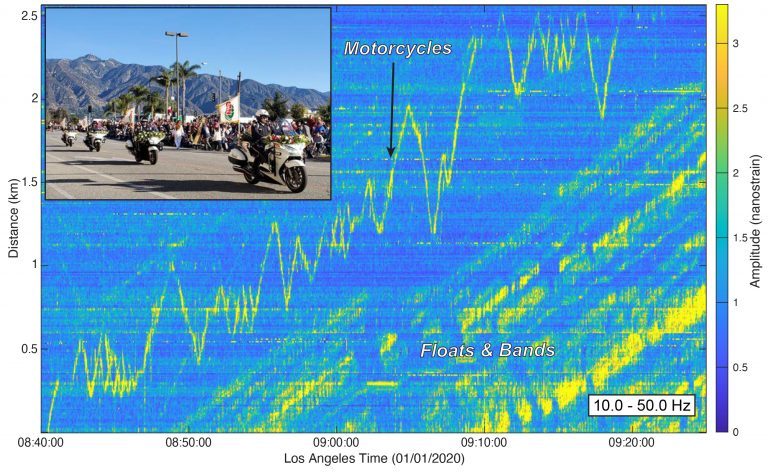May 7 2020
A well-known fact is a prize awarded for the most beautiful flower-filled float in the Rose Parade every year. What if a prize were awarded for the most ground-shaking marching band?
 Seismic records showing vibrations caused by motorcycles driving back and forth during 2020 Rose Parade. Image Credit: SRL.
Seismic records showing vibrations caused by motorcycles driving back and forth during 2020 Rose Parade. Image Credit: SRL.
A new study reports that the 2020 honors go to the Southern University and A&M College, closely followed by the hometown Pasadena City College Honor band.
Fiber-optic telecommunications cable laid below the parade route captured such bragging rights and other intriguing signatures of the Rose Parade. Zhongwen Zhan of the California Institute of Technology and collaborators report in Seismological Research Letters how these dark or “unused” fibers inside cables were converted into a dense seismic array.
The technique named distributed acoustic sensing (DAS) involves using the minuscule internal defects in a long optical fiber as thousands of seismic sensors. Laser pulses sent down the cable by an instrument located at one end of the fiber are reflected off the fiber defects and bounced back to the instrument.
When fiber is disturbed by an earthquake, variations in the size, phase, and frequency of the reflected pulses can be analyzed by the researchers to gain further insights into the resulting seismic waves.
In the case of the Rose Parade project, Zhan and collaborators investigated data from a 2.5-km (1.6 miles) stretch of cable beneath the parade route, which included nearly 400 seismic sensors. Here, the cables were disturbed by the compression and flexure of the roads by participants of the parade.
The main goal of the Pasadena Array is to detect small earthquakes and image the geological structure underneath the city. It has been operating only since November 2019, so we actually do not have any good-sized earthquake in the city yet. The Rose Parade, as a well-controlled event—no other traffic except the parade, traveling all in one direction at almost constant speed—provides a rare opportunity for network calibration.
Zhongwen Zhan, Researcher, California Institute of Technology
According to Zhan, their seismic readout “turned out to be quite broadband.” The seismic array captured the unique signals of the bending of the road when heavy floats weighing 16,000 to 18,000 kg (17.6 to 19.9 tons) passed above, zig-zagging police motorcycles that cleared the route, and a range of harmonic frequencies corresponding to the even stepping of the marching bands.
The “heaviest” float quantified thus was the Amazon studios float, including a bus and rocket mounted on a truck. The team could even observe a gap in the DAS record when the “Mrs. Meyer’s Clean Day” float was stuck at a tight turn along the route and blocked the parade traffic for six minutes.
This project inspires us that in the future we will probably use heavy vehicles for calibrations of DAS arrays in other cities.
Zhongwen Zhan, Researcher, California Institute of Technology
Since 1890, the annual Rose Parade is held on News Year’s Day and over 700,000 spectators throng the curbsides every year. The event is held before the Rose Bowl, an American college football game.
Journal Reference:
Wang, X., et al. (2020) Rose Parade Seismology: Signatures of Floats and Bands on Optical Fiber. Seismological Research Letters. doi.org/10.1785/0220200091.